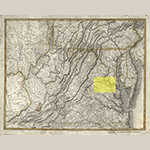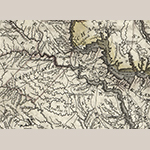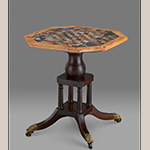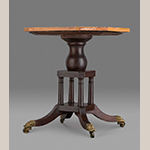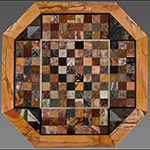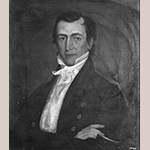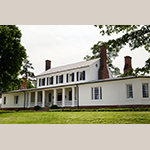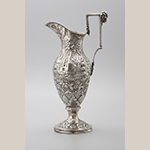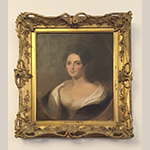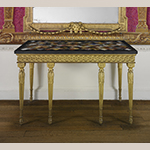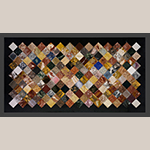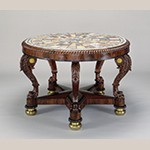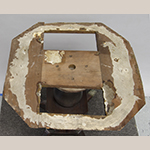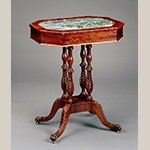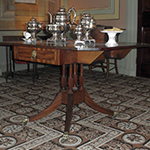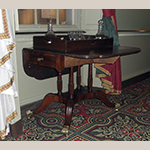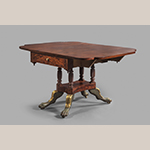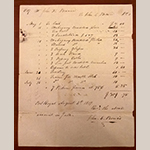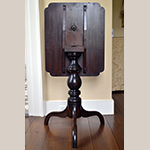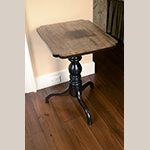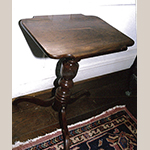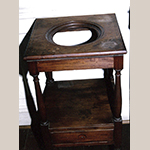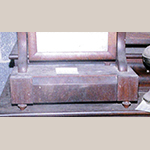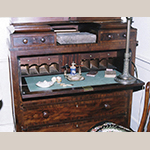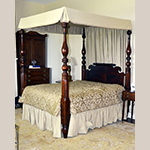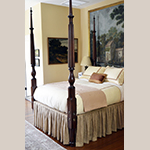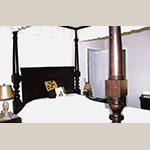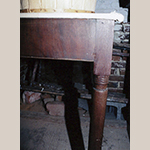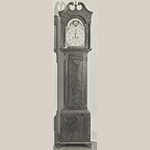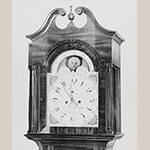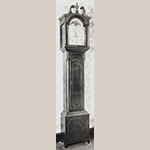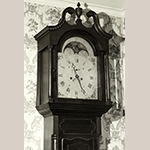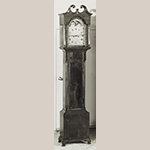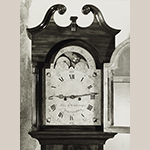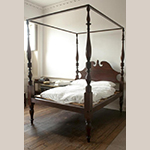The town of Port Royal, Virginia has never before been a focus of American furniture scholarship. A recent acquisition by Colonial Williamsburg, however, of an early nineteenth-century marble chess table, made in Italy, that descended in the family of planter John Hipkins Bernard has led to a discovery for the origin of the table’s base: that of the Port Royal cabinetmaking shop of John C. Bowie and his brother Walter Bowie.
— ♦♦◊♦♦ —
A small town surrounded by Caroline County on the south bank of the Rappahannock River, Port Royal developed in the mid eighteenth century around its tobacco warehouse, tavern, and ferry (Figures 1 and 2). As reverend Jonathan Boucher, an English-born tutor working in the household of Edward Dixon of Port Royal, wrote, the town “was chiefly inhabited by factors from Scotland, and their dependents, and the circumjacent country by planters in general, in middling circumstances.”[1] This local center for commerce and trade supported a number of artisans over the years, but in 1764 the merchant Edward Dixon purchased a set of chairs from Robert Walker (c. 1710–1770), a cabinetmaker who was working across the river in King George County, rather than from a Port Royal or Caroline County artisan.[2] While trade connections may have been a factor in this purchase, the absence of locally produced elegant furniture is a more likely reason.
The dearth of extant documentation and identifiable objects have limited any meaningful research into Port Royal’s eighteenth-century furniture makers. If the few carpenters who were documented to the town made furniture, they and their county colleagues may not have produced anything more than basic forms for the local Scottish factors and planters of middling circumstances.[3] Those who could afford to may have obtained more expensive, fashionable furniture in the mid to late eighteenth century from established furniture makers such as Robert Walker or from the cabinetmaking shops of James Allen (1716–1789) and Thomas Miller (d.1802) in Fredericksburg, just twenty miles up the Rappahannock River. At the end of the eighteenth and beginning of the nineteenth century as Fredericksburg grew as a regional center it drew cabinetmakers as well as other artisans from the surrounding region and from northern cities like Philadelphia. Most likely due to the higher concentration of customers, Robert Walker’s nephews and great nephews in the furniture and related trades centered their shops in Fredericksburg rather than the surrounding counties as Walker himself had done.[4]
But what of Port Royal’s cabinetmakers? Only brothers John Catlett Bowie (1786–1851) and Walter Bowie (1790–1853) are documented as being cabinetmakers in Port Royal in first quarter of the nineteenth century. They advertised the opening of their cabinetmaking shop in their hometown in 1812 stating that they would “keep on hand a constant supply of ready made fashionable mahogany furniture, of the best material and workmanship. Any orders from town or country will be attended to with promptitude and dispatch.”[5] Very little is known about the Bowie brothers or their business outside this 1812 advertisement. But recently discovered documentation suggests that one of them may have been the maker of a stand or chess table base purchased in 1820 by the wealthy Port Royal plantation owner John Hipkins Bernard (1792–1852) of Gay Mont. A short notation in Bernard’s ledger in 1820, “To amt pd Bowie for stand $10,” strongly suggests that John Bowie or Walter Bowie was the maker of the base for the imported Italian tabletop.[6] Bernard, who had taken a year-long European “Grand Tour” beginning in 1818, had purchased a marble chess tabletop in Rome as a souvenir (Figures 3 and 4). Like many such tabletops brought back to England and America in the eighteenth and nineteenth centuries, only the top (Figure 5) was acquired in Italy and a local craftsman was commissioned to make the mahogany and black walnut base.
— ♦♦◊♦♦ —
A native of Caroline County, Virginia, John Hipkins Bernard (Figure 6) fell in love with the arts of the continent while on his Grand Tour and upon his return was inspired to incorporate architectural, decorative, and landscape changes to his Port Royal home, Gay Mont (Figure 7). Indeed, his fascination with Classical design continued into the 1850s when he acquired an “Etruscan pitcher” from Baltimore silversmith Samuel Kirk (Figure 8).[7] In letters written home to his wife Jane Gay Robertson Bernard (1795–1852) (Figure 9) in 1819 Bernard described in vivid detail the places he visited in France and Italy and illustrated the enormous architectural and cultural differences between Europe and the new American nation. The homes, churches, operas, gardens, and ancient monuments Bernard visited overwhelmed him. He wrote from Rome, “For my part I shall be quite satisfied with viewing the most interesting; such as antiquities whose form & character have survived the wreck of time, and the striking masterpieces of art.”[8] His interests led to the purchase of a fashionable marble chess tabletop in Rome that was shipped from Naples in March 1819.[9] That same month, after describing numerous archeological sites, he wrote to his wife: “But enough of ruins, to enumerate wh[ich] would be to write 2 volumes from the perusal of wh[ich] I am sure you would willingly be excused; I think you will wear with greater pleasure a set of ruins wh[ich] I have just had executed for you in Mosaic than any wh[ich] such descriptions can give.”[10] With no other mosaic noted in the family papers or remaining at Gay Mont, this statement nearly certainly refers to the marble chess tabletop (see Fig. 5).
Beginning in the mid eighteenth century, tabletops composed of a selection of various marbles, stones, and minerals—typically adhered to a solid slate bed—were fashionable souvenirs for English and American tourists. Today these tabletops are sometimes referred to as “specimen tops.” Johann Jakob Ferber (1743–1790) wrote in 1776 that “A marble-cutter, living near Portici…and another at Naples…make marble-tables, with interseccatures of different sorts of lava…” and also “The Kingdom of Naples is provided with many sorts of marble… . They may be had, together with some antique marbles, in small polished samples at Naples. A marble-cutter at Capo di monte has made my collection.”[11] Marble specimens were brought back to England as tabletops or as loose stones that could be kept as a collection or incorporated into furniture. Georg Haupt (1741–1784), a Swedish-born cabinetmaker working in London, made a small table for Sir William Chambers in 1769 from Chamber’s own design with nine large square specimens of marble set into the top (not illustrated).[12] A decade earlier, Lord Coventry had purchased a marble-top table from John Wildsmith (w.1757–1769) of London (Figure 10). Wildsmith inlaid the top with 176 squares of different colored hardstone specimens in a diagonal checkerboard pattern to display “all the curious sorts” of stone (Figure 11). At the beginning of the nineteenth century, this proclivity for marble specimen tops inspired Americans as well English tourists. E. H. Derby of Salem, Massachusetts returned from his Grand Tour in 1800 with “Curiosities from Italy he had collected” including “The marble & inlaid tables.” And in 1841 Edward Coleman of Lancaster and Philadelphia, Pennsylvania, left his daughters his “marble mantles and tables” (Figure 12) that he had “imported from Rome” fourteen years previously.[13]
While no copy of the original order or invoice for the Bernard’s marble tabletop survives in the family papers, there are tantalizing pieces of evidence that indicate the path that the tabletop traveled. John Bernard’s previously mentioned letter from Rome in March 1819 suggests that he had just ordered the top.[14] Later that year his accounts mention that a “marble slab” (referring to a tabletop) was shipped on the “Ship Pernasso” from Naples, Italy. This ship, helmed by Captain Hitch, was reported as having arrived in New York from Naples (by way of Gibraltar, Trapani, and Gibraltar again) on 29 February 1820.[15] The New York merchants Byrnes & Trimble, whose partner Silas Wood (1787–1852) resided in nearby Fredericksburg, Virginia, were responsible for the shipment. A payment that John Bernard noted through merchants Thomas Goodwin & Sons of Fredericksburg to the New York firm in April 1819 for $157.10 might be for the tabletop itself. The firm billed Bernard for the duties and cartage charges to the “Schooner Chasseur” on 25 March 1820 and received payment from him in June of that year.[16] The schooner left New York for Fredericksburg on 25 or 26 March 1820, presumably with the tabletop aboard.[17] Whether it was offloaded in Fredericksburg or in Port Royal is unknown, but other ships bound for Fredericksburg made multiple stops along the Rappahannock River when necessary.[18] Byrnes & Trimble (through their Virginia partner Silas Wood) or Thomas Goodwin & Sons may have received the tabletop in Fredericksburg for Bernard. But since there is no record in the family papers or in Bernard’s ledger mentioning cartage from Fredericksburg, it more likely was delivered directly to him in Port Royal.
— ♦♦◊♦♦ —
After John Bernard presented his marble mosaic gift to his wife, the couple needed to identify a cabinetmaker to produce the base for their imported Italian tabletop. The Bernards would have considered the type of design they desired, who could complete such a commission, and where they were located. The base was almost certainly made in proximity to the top given the octagonal framework of the base’s top that matches the stone top itself and the registration pins that located the top securely onto the base (Figure 13). Living in Port Royal, the Bernards had access to the work of artisans from the nearby major urban centers of Baltimore, Norfolk, Fredericksburg, and Richmond. Indeed they purchased a sideboard from Norfolk in 1819 and a Fancy-painted couch that descended in the family was produced in Baltimore around the same time.[19] The couple also would have been aware of the most fashionable furniture of America and Europe, including the New York and Baltimore designs that a number of Virginia cabinetmakers emulated in order to compete with imports from those cities.[20]
Knowledge of tables like those by Charles-Honoré Lannuier (1779–1819) of New York City who made an octagonal stand with a solid marble inset top (Figure 14) might have informed the maker of the Bernard’s chess table base.[21] The Lannuier stand has four double-baluster-shaped, foliate-carved columns supporting the octagonal top. The columns rest on a solid base with four foliate-carved saber legs with carved paw feet. The Bernards’s cabinetmaker used the same form with the addition of a thick central baluster directly under the top (see Fig. 4). Perhaps the cabinetmaker thought an element with greater mass than the four columns was necessary for the extra weight of the top. His design was not quite as successful as the French-trained Lannuier’s, but the base was stable, secure, fashionable, and neat and plain. And while his well-made turned baluster and simple columns were not embellished with any carving, he did carefully veneer the top of the plinth on which the baluster rests to hide the joints (possibly wedged through-tenons) for the columns below.
A handful of Richmond and Norfolk breakfast tables (Figures 15, 16, and 17) of the period survive that utilize four columns of the type seen both on the Bernards’s table and New York examples.[22] While the Bernards could have commissioned their table base from a Richmond or Norfolk cabinetmaker, there is not enough stylistic evidence to support a solid attribution to either city. John and Gay Bernard did travel to Richmond periodically, including in 1820, but there is no evidence that the tabletop was shipped to or from Richmond or Norfolk for the base to be made.[23] The use of the four columns on Richmond and Norfolk tables was influenced by fashionable New York designs and the work of northern cabinetmakers working in those southern cities. These same factors might have inspired other Virginian cabinetmakers including John Bowie and his brother Walter Bowie.[24] While the maker of the Bernards’ table base was certainly not a New York cabinetmaker of the caliber of Lannuier, the design of the base was in a fashionable, albeit plain style. The execution of the work was quite neatly done indicating a well-trained craftsman.
The knowledge that the tabletop was in Port Royal and possibly Fredericksburg but no other Virginia cities combined with John Bernard’s notation, “To amt pd Bowie for stand $10,” a few months after the tabletop arrived in Virginia make it a near certainty that the table base was made in 1820 by John Bowie in Port Royal or his brother Walter Bowie, who had moved to neighboring Essex County by that date.[25] A few years earlier, in 1817, the Bernards had purchased a number of pieces of bedroom and parlor furniture from John Bowie. Despite John Bowie’s name on the invoice, it is unknown when the brothers’ partnership dissolved or exactly when Walter had moved to Essex County. It is possible that Walter still could have been involved in the production or acquisition of these pieces in 1817 and 1820. Included in the list of furniture John Bowie sold to the Bernards in 1817 were a tea table, candle stands, beds, a secretary, and frames for two marble slabs (Figure 18).[26] The number of pieces and inclusion of multiple forms suggest that the Bernards considered Bowie a competent and presumably fashionable cabinetmaker. The only other furniture forms the couple is documented to have purchased outside Port Royal were a sideboard from Norfolk in May 1819 and two marble side tables in 1816 from an unknown source ordered through a Port Royal merchant, Reuben Gravate (or Gravette), the brother-in-law of John Bowie’s wife Jane Timberlake Bowie (d.1823).[27] These marble slab tables may have been purchased for the marble itself as the following year Bowie made a pair of frames for slabs, very possibly to replace potentially unfashionable frames that were initially purchased with those tops. The previously mentioned Fancy-painted Baltimore couch that survives with a history in the family suggests there may have been additional purchases that are not documented in the family papers.[28] But the Bernards’s reliance on John Bowie for the majority of their known furniture purchases suggests that they would have turned to him rather than to someone in Fredericksburg or further afield for the base of their imported marble chess tabletop.
A survey of the family furniture that survived at Gay Mont in 1999 when the house was donated to the Association for the Preservation of Virginia Antiquities (now Preservation Virginia) reveals a handful of items that may be those listed on the 1817 invoice for furniture John Bowie sold to the Bernards. A tilt-top tea table (Figure 19 and 20) and a candle stand (Figure 21), both with heavily turned pillars including compressed baluster turned elements may be those items priced at $14 and $6 or $7 on Bowie’s bill. A mahogany and tulip poplar washstand with columnar supports (Figure 22) may be one of the two washstands Bernard purchased together for $9. A mahogany-veneered dressing glass (Figure 23) may be one of the two examples of this form valued at $13 each. A mahogany-veneered secretary (Figure 24) with cross-banded veneers around the drawers may be the $60 secretary. And the three tall post beds may be the “mahogany bedstead plain,” “mahogany bedstead fluted,” and “Stained Do” priced at $55, $80, and $18, respectively (Figures 25, 26, and 27). Finally, a large rectangular mahogany and mahogany veneered table with simple ring-turned legs that was noted in 1980 as having lost its marble top may be one of the two frames for marble slabs that Bowie produced for $10 each (Figure 28).
The columnar supports on the Gay Mont washstand (Fig. 22) feature a small detail that relates to columns on the chess table base (Fig. 4) and to those on the hood of a tall case clock that currently is the only piece of furniture attributed to Walter Bowie (Figures 29 and 30).[29] Each of these columns has a delicate ring turning about one inch below the top of the column. Similar ring turnings appear on a tall clock case attributed to Robert Walker III (w.1800–1809) of Fredericksburg and dated to 1809–1811 (Figures 31 and 32) as well as another 1810–1820 Fredericksburg case with a movement by John Weidemeyer (w.c.1800–1822) of Fredericksburg (Figures 33 and 34). These delicate turnings follow architectural designs that correspond to the astragal below the neck or collarino on a modified Doric column.[30] They are not unique to Fredericksburg columns, but it is interesting that they appear on two clock cases from Fredericksburg as well as the one clock attributed to Walter Bowie and the washstand and chess table base made by John and/or Walter Bowie.
The two mahogany beds (Fig. 25 and Fig. 26) and the turned tea table (Fig. 19) at Gay Mont appear from close inspection to all be turned by the same hand or in the same shop. The third bed (Fig. 27) has not been examined, but its turnings patterns and baluster shapes are quite different from the other two beds, suggesting it might be by a different hand. Of the two mahogany beds, the one with the ring turnings and balusters that are not fluted (Fig. 25) has almost identical posts to a bed found in a Norfolk antique shop (not illustrated) and attributed to that city based on its similarities to a bedstead in the Moses Myers House (Figure 35). The Myers bed is attributed to the shop of James Woodward (w.1793–1839) of Norfolk based on its relationship to another documented bed Woodward made for Humberston Skipwith in 1819 (not illustrated).[31]
Turned pedestal-based tables and stands with Norfolk provenances and turnings similar to the Gay Mont tea table have also been located.[32] The Norfolk connection for these turned Gay Mont pieces suggests that either John Bowie was importing and retailing Norfolk furniture in Port Royal, or that he, his brother Walter, or an unknown worker may have trained or worked in Norfolk just prior to 1817.[33] Since the Bowie brothers opened their Port Royal shop in 1812, they are unlikely to have been exposed to this style of turning during their training. The third Gay Mont bedstead with the different turning patterns supports the idea of multiple makers or suppliers of the turned elements for the Bowie shop. The two extant headboards on these beds are also quite different, adding to the notion that the beds were made by different hands or in different shops.
A closer comparison of the chess table base with the turned baluster on the Gay Mont tea table and baluster turnings on the bedsteads reveals that the chess table base was most likely not made by the same turner as the tea table and bedsteads. The form of the two tables is extremely dissimilar but so is the simplicity of the baluster turning on the chess table compared to the busy baluster and rings on the tea table. If the Bowies imported the tea table and bedsteads from Norfolk, the simplicity and streamlined nature of the chess table base suggests that it was more likely a Bowie product. The relationship between the columns on the chess table base and the Gay Mont washstand suggests that the latter may also have been produced in the Bowie shop, thus indicating that the Bowies were most likely both cabinetmakers and retailers.
— ♦♦◊♦♦ —
As previously mentioned, the only documentation for brothers John and Walter Bowie’s cabinetmaking business is their 29 April 1812 advertisement in the The Virginia Herald of Fredericksburg where they announced the opening of their business in Port Royal. A few references also exist to coffins made by John and Walter for clients in neighboring Caroline County and by Walter in neighboring Essex County after 1819.[34] None of the Bowie family genealogists have noted John or Walter Bowie’s involvement in the cabinetmaking trade. Indeed, the author of The Bowies and their Kindred: A Genealogical and Biological History wrote that John Bowie “attended the academy in Port Royal, and…received an excellent education… . After leaving school he resided with his father until 1812, when he enlisted..and…served in the war against Great Britain.”[35] As the eldest child, John Bowie inherited his father’s estate, The Hill in Port Royal after James Bowie was murdered in 1817. According to The Bowies and their Kindred, John “was devoted to agriculture, a practical farmer, and ornamented the grounds around his dwelling with flowers and shrubbery. The garden was laid out with walks and borders after the English style, and fringed with fruit trees.” This description suggests a substantial estate, which also included part ownership in a large flour mill.[36] His inheritance of that estate in 1817 may have been the reason for John abandoning his trade for the more lucrative family agricultural business. The short duration of his shop, from 1812 until around 1820 might also explain why there was no knowledge of his woodworking career by his descendants. John Bowie’s obituary, written by his cousin Dr. J. J. Gravette in 1851, stated “Agriculture has lost one of its greatest votaries – society one of its brightest ornaments.”[37]
Very little is known about Walter Bowie. According to The Bowies and their Kindred, Walter, like his older brother, was educated at the academy in Port Royal. He did not enlist in the War of 1812, but rather remained at home to assist his father in the management of the estate. He married Julia A. Spindle of Essex County in 1814, and by 1820 was living in Essex County on an estate with twenty-three slaves. Three years later he married his second wife Mary S. Todd at Hickory Grove in Caroline County, and by 1830 his estate had grown to forty-two slaves.[38] Given the extent of his agricultural holdings, it is quite likely that Walter also abandoned any furniture making that he had done as a young man.
With no family recollections or further documentation of the Bowie brothers working as cabinetmakers is it difficult to know when and where they might have learned their craft. Both the tall case clock attributed to Walter Bowie and the marble chess table base suggest the maker was well trained in the art and mystery of cabinetry and could produce elegant, fashionable, neat and plain furniture; however, although fashionably styled and elegantly constructed, the table base lacks the sophistication of a large urban cabinetmaking shop of the period. The quality of construction and knowledge of fashionable designs suggests training in a larger center than Port Royal, possibly Fredericksburg, Richmond, or Norfolk. Fredericksburg was the nearest city that hosted a handful of cabinetmakers in the late eighteenth and early nineteenth century. The columns on the hood of the inlaid tall case clock by Robert Walker III (Fig. 31 and Fig. 32), cabinetmaker and turner of Fredericksburg, from 1809 are similar to those on the clock attributed to Walter Bowie (Fig. 29 and Fig. 30) suggesting a possible relationship.
Not much is known of the work or training of this generation of Walker cabinetmakers, which includes Robert III, Thomas N. (working by 1804), and Alexander (1771–1830), who was the most firmly established of the clan during that period.[39] Unfortunately, while the overall design of the Bowie and Walker III clock cases are related and the rosettes in their pediments have similar pinwheels, one carved and the other inlaid, there is not enough similarity between them to indicate a closer connection. Without a direct link to one of the Walkers it is impossible to know if John or Walter Bowie trained or worked with any of these Fredericksburg cabinetmakers.
The possibility also exists for John or Walter Bowie to have trained or worked in Norfolk, or even to have hired an extra hand in their shop who had worked there. The similarities in turnings between the Gay Mont turned beds and tea table and Norfolk examples indicates a very strong link. But it is just as possible that the Bowie’s were purchasing Norfolk-made furniture and retailing it in Port Royal to augment any work they were doing themselves. Norfolk was an easy trip by water during the early nineteenth century and John Bowie could have been acting as middleman as well as a cabinetmaker to acquire some or all of the fashionable forms the Bernards needed in 1817.
While documentation for Norfolk cabinetmakers selling bedposts is not known, it was probably done. Evidence does exist for such a practice in Fredericksburg, where Alexander Walker advertised in 1817 that he had “a large quantity of Bed-Pillars in sets” for sale.[40] A cabinetmaker with a small shop might not have had access to a lathe or have been a proficient turner. In order to provide fashionable beds for his customers, he might acquire pre-made turned bed pillars and fabricate the rails and other elements himself. Thus it is a possibility that John or Walter Bowie purchased bed pillars or complete beds from Norfolk or elsewhere.
The nature of urban Virginia cabinetmaking shops was evolving in the early nineteenth century. Whereas most eighteenth-century shops had consisted of a master and a few journeymen and apprentices producing bespoke pieces, nineteenth-century shops often had multiple workmen and readymade furniture on hand in their wareroom. In Fredericksburg, Alexander Walker advertised he had “on hand a large parcel of fashionable Furniture & Windsor chairs, Made of good materials…” in 1808 as well as nearly “400 CHAIRS finished on hand” of either the Windsor or Fancy variety in 1805.[41] James Woodward had a large cabinet shop in Norfolk in 1795 where he stocked a large variety of cabinet forms including “Chairs, Sideboards, set of Card, Pier, Pembroke, Tea, Dining Tables…mahogany 4 post Bedsteads…and a number of other articles.”[42] Chester Sully (1781–1834) opened his Norfolk cabinet shop in 1805 and in 1811 expanded to include satellite shops in Edenton, North Carolina, in Richmond in 1813, and Lynchburg in 1814.[43] Sully relied on partners and workmen to manage the various sites and produce the fashionable furniture.
As the nineteenth century progressed, many cabinetmakers were evolving from artisan to entrepreneur. John and Walter Bowie were from a prosperous family and according to their family history received academic educations rather than apprenticeships. While one or both of them could have apprenticed to a cabinetmaker at some point in time, it is also possible that they focused on the entrepreneurial side of the business, perhaps retailing furniture from other, larger shops or acquiring items from further afield for their clients. Producing all the furniture they sold themselves would have put them in direct competition with other regional cabinetmaking centers like Fredericksburg, Richmond, and Norfolk. Given how easy it was for Port Royal inhabitants to acquire furniture from those cities, the Bowies probably could not rely solely on their own skills to compete. Even the larger shops in those urban centers competed with imports from northern cities like New York, Philadelphia, and Baltimore, advertising that could “execute all orders with which he may be favored, equal to any importation, and upon as reasonable terms.”[44] Where regional and northern imports were readily accessible, small town cabinetmakers had to change from the eighteenth-century model. The Bowie brothers may represent a new trend of combining locally produced items with regional imports. But like many eighteenth-century artisans, nineteenth-century craftsmen like the Bowies still aspired to be landed gentlemen and planters. The Bowie brothers both fulfilled this aspiration thus curtailing their craft and entrepreneurial occupations.
— ♦♦◊♦♦ —
The Bernard family marble chess table is an important document of the global view of Tidewater Virginians during the early nineteenth century as well as their parochial connections. Very few Italian marble specimen top tables have survived with their American histories intact.[45] No others can be documented on a specific ship or from a named Italian port. While not everything is known about this tabletop, John Bernard’s participation in a European Grand Tour and the couple’s acquisition of objects such as the tabletop, French wallpapers (one depicting the Bay of Naples), and later in the nineteenth century a silver “Etruscan pitcher” from Baltimore (Fig. 8) speaks to their understanding of America’s and Virginia’s place within the global economy and culture.
While this worldview provided the Bernards with the knowledge, experience, and ability to procure elegant furniture from as far afield as their pocketbooks allowed, the couple’s acquisition of a table base from a local cabinetmaker underscores their place within Virginia society and the Port Royal community. The Bernards were among the landed elite of Tidewater Virginia and as such could have purchased a table base from any urban cabinetmaking shop along the coast, yet they patronized a local craftsman with whom they had dealt previously to supply the base to this important souvenir of their European trip. So important was the table that it was one of only a handful of objects that Jane Gay Robertson Bernard delineated as special bequests to her children.[46]
Perhaps bonds of friendship or community led to the choice of the Bowies to make the chess table base. Unfortunately for the Bernards and Port Royal clients like them, Walter Bowie’s move out of town and John Bowie’s inheritance of his father’s estate led to the loss of a cabinetmaking shop in Port Royal. No other cabinetmaker is known to have filled the void, perhaps illuminating a trend by the local mercantile and landed elite to obtain their elegant furniture from fashionable suppliers in urban centers such as Fredericksburg, Norfolk, Baltimore, and New York. The Bowie brothers may have supported this trend by retailing or supplying some Norfolk furniture to clients like the Bernards in 1817. But even if they had remained in business, the Bowies may have found that their business model was unsustainable for their market as the nineteenth century progressed and competition increased.
Tara Gleason Chicirda is Curator of Furniture for The Colonial Williamsburg Foundation. She can be contacted at [email protected].
[1] As quoted in Edward Duffield Neill, Notes on the Virginia Colonial Clergy (Philadelphia, PA: n.p., 1877), 29.
[2] Robert A. Leath, “Robert and William Walker and the ‘Ne Plus Ultra’: Scottish Design and Colonial Virginia Furniture, 1730–1775”, American Furniture, 2006, edited by Luke Beckerdite (Milwaukee, WI: Chipstone, 2006), 81; available online: http://www.chipstone.org/article.php/559/American-Furniture-2006/Robert-and-William-Walker-and-the- (accessed 18 February 2018).
[3] Most woodworkers documented in the MESDA Craftsman Database in Caroline County, Virginia were listed as carpenters. Many if not most of them were probably house carpenters, but there is also the probability that some made furniture. There was elegant furniture being produced in the Caroline County area in the mid eighteenth century that has not yet been attributed to a specific maker.
[4] Leath, 88 and Tara Gleason Chicirda, “The Furniture of Fredericksburg” American Furniture, 2006, edited by Luke Beckerdite (Milwaukee, WI: Chipstone, 2006), 126-132; available online: http://www.chipstone.org/article.php/563/American-Furniture-2006/The-Furniture-of-Fredericksburg,-Virginia,-1740–1820 (accessed 18 February 2018).
[5] Virginia Herald (Fredericksburg, VA), 29 April 1812, 1-1.
[6] Bernard-Robb Papers, Mss. 65 R54, Box 1, folder 5, Ledger, p. 103, “House and Miscellaneous Expenses,” 13 October 1820, Special Collections Research Center, Swem Library, College of William and Mary, Williamsburg, VA.
[7] An October 1854 entry in Bernard’s account book reads: “Paid to Sam’l Kirk & Son-$81.00.” The Samuel Kirk & Son books include an entry in December 1854: “Chas. Tiernan for J.H. Bernard / 1 Etruscan Pitcher $85.” MESDA Collection Record for Acc. 5541; available online: http://mesda.org/item/collections/pitcher/20580/ (accessed 18 February 2018).
[8] Bernard-Robb Papers, Mss. 65 R54, Series 3-5, #1979.18, “Typescript of a Journal of John Hipkins Bernard,” p. 58, March 1819.
[9] Ibid, Mss. 65 R54, Box 1, folder 5, Ledger, p. 103, “House and Miscellaneous Expenses,” 2 June 1820 and “Thomas Goodwin & Sons contra Cr,” 9 April 1819 and Box 2, folder 4, receipt for charges for duties and cartage billed by Byrnes & Trimble, 13 March 1820.
[10] Transcriber James Samuel Patton noted that the word “wear” was an outdated term for “use.” Ibid, Mss. 65 R54, Series 3-5, #1979.18, “Typescript of a Journal of John Hipkins Bernard,” p. 63, 28 March 1819.
[11] Johann Jakob Ferber, Travels Through Italy: in the years 1771 and 1772 (London: L. Davis, 1776), 111.
[12] Victoria & Albert Museum, Table #W.38:1 to 3-1977; available online: http://collections.vam.ac.uk/item/O8156/table-chambers-william-sir/# (accessed 18 February 2018).
[13] The center table illustrated in Fig. 12 has no history but is identical to a table that descended from Edward Coleman’s daughter Harriet. Coleman had “2 Italian Marble Tables” in his back parlor when he died in 1841 that may have been the “tables imported from Rome” that he collected during his European visit in 1827 and left to his daughters. Will and Inventory of Edward Coleman, 1841, Philadelphia probate records, no. 113, Will Book 15:38; as cited in Wendy Cooper, Classical Taste in America (New York: Abbeville, 1993), 59-60.
[14] Bernard-Robb Papers, Mss. 65 R54, Series 3-5, #1979.18, “Typescript of a Journal of John Hipkins Bernard,” p. 63, 28 March 1819.
[15] New-York Gazette & General Advertiser (New York, NY), 29 February 1820, 2: “Arrived. The Ship Parnasso, Hitch, from Trapani, and 60 days from Gibraltar, with wine, raisins, filberts, oil, silks, &c. to Fish & Grinnell, Byrnes, Trimble & Co… .” The ship had been to Naples after Gibraltar (17 September 1819) and before Tripani. American Beacon and Norfolk & Portsmouth Daily Advertiser (Norfolk, VA), 10 November 119, 3: Under “From Lloyd’s list of Sept. 17” and “At Gibraltar, Parnasso, Hitch, New-Orleans.” Mercantile Advertiser (New York, NY), 30 November 1819, 2: “The ship Pernasso, Hitch, from this port [New York], arrived at Naples 27th Sept.”
[16] The “Schooner Chasseur” might be a vessel of that name that was called the Pride of Baltimore as a privateer during the war of 1812. Bernard-Robb Papers, Mss. 65 R54, Box 1, folder 5, Ledger, p. 103, “House and Miscellaneous Expenses” 2 June 1820 and “Thomas Goodwin & Sons contra Cr,” 9 April 1819 and Box 2, folder 4, receipt for charges for duties and cartage billed by Byrnes & Trimble 13 March 1820.
[17] Mercantile Advertiser (New York, NY), 24 March 1820, 1: “For Fredericksburg. The fine schr Chasseur, S. Kirwan, master…will clear on Saturday, and sail the first favorable wind thereafter… .” The New-York Columbian (New York, NY), 27 March 1820, 2: “Ship News. Port of New-York,” and “Cleared. Schrs…Chasseur, Kirwin, Fredericksburg.”
[18] Advertisements in early nineteenth-century American newspapers indicate that ships bound for Fredericksburg would take goods for Port Royal and Tappahannock as well. Advertisement for the schooner Mentor in Baltimore Patriot (Baltimore, MD), 17 March 1813, 1.
[19] A red and yellow Baltimore painted couch with a family history, possibly made by Hugh and John Finlay, survives at Rose Hill (Gay Mont). Bernard-Robb Papers, Mss. 65 R54, box 1 folder 5, ledger, p. 50.
[20] Cabinetmaker James Woodward of Norfolk advertised that he had “…the best workmen from Philadelphia and New York, and from Europe… .” The Herald and Norfolk and Portsmouth Advertiser (Norfolk, VA), 28 January 1795, 3:4. Cabinetmaker Alexander Walker of Fredericksburg advertised that he could make furniture “…of the newest fashions, and at the northern prices—when the quality is equal, if not superior, risk and freight saved… .” The Virginia Herald (Fredericksburg, VA), 13 July 1802, 3:3. Walker also advertised “…Equal if not superior to any manufactured in Baltimore… .” Ibid, 12 August 1803, 1:1.
[21] Peter M. Kenny, Honoré Lannuier Cabinetmaker From Paris (New York: Metropolitan Museum of Art, 1998), plate 68.
[22] The Pembroke table illustrated in Fig. 16 has a history of descent in the Wickham family of Richmond. For Norfolk examples, see Thomas R. J. Newbern and James R. Melchor, Classical Norfolk Furniture 1810–1840 (Paducah, KY: Turner, 2004), 22-26.
[23] Bernard-Robb Papers, Mss. 65 R54, Box 1, folder 5, Ledger, p. 103, “House and Miscellaneous Expenses,” 22 September, “To amt pd Gay to go to Rd $62.50.”
[24] The table is probably not from Norfolk as a good bit is known and has been published about classical Norfolk furniture. See Newbern and Melchor.
[25] Bernard-Robb Papers, Mss. 65 R54, Box 1, Folder 5, Ledger, p. 103, “House and Miscellaneous Expenses”, 13 October 1820. The value of $10 for the 1820 stand is appropriate based on John Bowie’s 1817 charges of $14 for a tea table and $6 and $7 for candle stands. The timing of the 1820 payment also fits quite nicely with how long it might have taken Bowie to make a stand once the top arrived in Port Royal in April of that year and for Bernard to follow up with payment in October.
[26] Ibid, Mss. 65 R54, Box 2, Folder 1, Item 1, JH Bernard notes, bills…1812–1818, Bill/receipt May-July 1817, Mr. John H. Bernard to John C. Bowie Dr. The frames for marble slabs may have replaced frames that came with the marble slab tables the Bernards purchased from Reuben Gravate for $67 on 20 December 1816 (Ibid, Account with Reuben Gravate).
[27] Ibid, Mss. 65 R54, box 1 folder 5, ledger p. 50 and Box 2, Folder 1, Item 1 JH Bernard notes, bills…1812-1818.
[28] On 2 November 1816 John H. Bernard paid Reuben Gravate “Cash Paid Freight of Articles from Baltimore $17.” While he did not specify the articles shipped, furniture may have been included in that order. Ibid, Mss. 65 R54, Box 2, Folder 1: John H. Bernard notes, bills, receipts 1812–1818, John H. Bernard account with R. Gravatte.
[29] The tall case clock descended in the Murphy family of Westmoreland County, Virginia. Tradition is that the case was made by Walter Bowie, who married (his second wife) Mary S. Todd at Hickory Grove in Caroline County in 21 October 1823. MESDA Object Database File S-5002; online: http://mesda.org/item/object/clock-tall-case/15756/ (accessed 18 February 2018).
[30] Robert Tavernor and Richard Schofield, Andrea Palladio The Four Books on Architecture (Cambridge, MA: MIT, 2002), 23.
[31] Newburn and Melchor, 27-29, 113.
[32] Newburn and Melchor, 114.
[33] Tom Newburn and Jim Melchor have suggested that Norfolk shops may have sub-contracted the production of turned elements like bed posts and stand/table pedestals. These turned elements could even have been shipped to cabinetmakers in other locales, like the Bowie brothers in Port Royal, for incorporation into their furniture. While specialized work was certainly sub-contracted during this period in various cities, there is no documentation for this between Norfolk and Port Royal, or another distant city. But it cannot be ruled out.
[34] Coffin accounts for John C. and Walter Bowie can be found in Caroline County, Virginia Will Book no. 19, 1814-18, p. 43; Essex County, Virginia Wills no. 19, 1816-23, p. 377; and no. 20, 1824-26, p. 65. Cited from MESDA Craftsman Database, Walter Bowie (ID No. 3523); online: http://mesda.org/item/craftsman/bowie-walter/3500/ (accessed 18 February 2018).
[35] Walter Worthington Bowie, The Bowies and their Kindred: A Genealogical and Biological history (Washington, DC: Cromwell Bros, 1899), 285-286;available online: https://archive.org/details/bowiestheirkindr1899bowi (accessed 19 February 2018). John C. Bowie’s War of 1812 Pension application indicates he was only in the military from January 1813 to March 1813. There is no pension application for Walter Bowie (War of 1812 Pension Application Files Index, 1812–1815, Records of the Department of Veterans Affairs, National Archives, Washington, DC).
[36] Bowie, 284, 286.
[37] Ibid, 287.
[38] Ibid, 288–289 and 1820 United States Federal Census, Essex County, VA.
[39] Leath, 88 and Chicirda, 127–132.
[40] The Virginia Herald (Fredericksburg, VA), 11 June 1817, 3:5.
[41] Ibid, 12 November 1808, 3:3 and Ibid, 26 April 1805, 3:3.
[42] American Gazette (Norfolk, VA), 1 September 1795, 1:3 and The Herald and Norfolk and Portsmouth Advertiser (Norfolk, VA), 28 January 1795, 3:4.
[43] Ibid, 2 April 1805, 3:3; Edenton Gazette (Edenton, NC), 25 June 1811, no pagination; The Enquirer (Richmond, VA), 9 July 1813, 1:1; and The Lynchburg Press (Lynchburg, VA), 3 November 1814, 3:5.
[44] The Virginia Herald (Fredericksburg, VA), 22 August 1815, 3:5 and American Gazette (Norfolk, VA), 27 March 1793, 3:2.
[45] In addition to the center table illustrated in Fig. 12, other American specimen top tables include: 1) Nathan Appleton or his brother Samuel Appleton of Boston, MA owned a specimen top pier table with a frame made in Boston, 1810–1825, the frame possibly by the cabinetmaking firm of Isaac Vose and Joshua Coates, that their cousin Thomas Appleton, American consul at Livorno, Italy may have procured (Cooper, 61-62 and Richard C. Nylander, “A French Secretary, Family Ties, and Serendipity,” Antiques & Fine Arts [Winter 2016]: 158–159); 2) A rosewood center table by Isaac Vose & Son, Boston, 1818–1822 owned by David Sears Jr. of Boston, a neighbor of Samuel Appleton (Detroit Institute of Arts Museum, Acc. #2006-88, see Robert D. Mussy Jr. and Clark Pearce, “Classical Excellence in Boston: The Furniture of Isaac Vose” in Boston Furniture 1790-1900, Brock Jobe and Gerald W. R. Ward, eds. [Boston, MA: Colonial Society of Massachusetts, 2016), 277); Specimen top tables made by Charles Honnoré Lannuier include 3) a small center table circa 1810 that may have descended in the Livingston family and 4) a small square table made in 1804 for Commodore Richard Valentine Morris (owned in the White House Collection and Morristown National Historic Park, respectively; illustrated in Kenny, cat. 116 and cat. 117); 5) A center table by Anthony Quervelle, Philadelphia, PA, ca. 1830, Metropolitan Museum of Art, Acc. 68.96; and 6) another center table by Quervelle, circa 1830, Kaufman Americana Collection, National Gallery of Art.
[46] Bernard-Robb Papers, Mss. 65 R54, Box 2, Folder 4, item 3, legacies of Jane Gay Bernard.
© 2018 Museum of Early Southern Decorative Arts

